The Impact of Structure Similarity of Nontariff Measures on Agricultural Trade
Abstract
1. Introduction
2. Trend of Nontariff Measures (NTMs)
2.1. The Entire Industry
2.2. The Agricultural and Food Industry
3. Methods
3.1. Quantifying NTM Structure Similarity
3.2. The Similarity of NTM Structure in the Gravity Equation
4. Results
5. Discussion and Conclusions
Author Contributions
Funding
Acknowledgments
Conflicts of Interest
References
- Kee, H.L.; Nicita, A.; Olarreaga, M. Estimating Trade Restrictiveness Indices. Econ. J. 2009, 119, 172–199. [Google Scholar]
- Orefice, G. Non-Tariff Measures, Specific Trade Concerns and Tariff Reduction. World Econ. 2017, 40, 1807–1835. [Google Scholar] [CrossRef]
- United Nationas Economic and Social Commission for Asia and the Pacific (UNESCAP); United Nations Conference on Trade and Development (UNCTAD). Navigating Non-Tariff Measures towards Sustainable Development; United Nations Publication: New York, NY, USA, 2019; ISBN 978-92-1-120795-8. [Google Scholar]
- World Trade Organization (WTO). The WTO Agreement Series: Sanitary and Phytosanitary Measures; WTO: Geneva, Switzerland, 2010; ISBN 978-92-870-3803-6. [Google Scholar]
- Beghin, J.; Disdier, A.-C.; Marette, S.; Tongeren, F.V. Welfare costs and benefits of non-tariff measures in trade: A conceptual framework and application. World Trade Rev. 2012, 11, 356–375. [Google Scholar] [CrossRef]
- Cadot, O.; Gourdon, J.; van Tongeren, F. Estimating Ad Valorem Equivalents of Non-Tariff Measures: Combining Price-Based and Quantity-Based Approaches; OECD Publishing: Paris, France, 2018. [Google Scholar]
- Disdier, A.-C.; Fontagné, L.; Mimouni, M. The Impact of Regulations on Agricultural Trade: Evidence from the SPS and TBT Agreements. Am. J. Agric. Econ. 2008, 90, 336–350. [Google Scholar] [CrossRef]
- Swann, P.; Temple, P.; Shurmer, M. Standards and Trade Performance: The UK Experience. Econ. J. 1996, 106, 1297–1313. [Google Scholar] [CrossRef]
- Moenius, J. Information Versus Product Adaptation: The Role of Standards in Trade; Working Paper; International Business & Market Research Center: Evanston, IL, USA, 2004. [Google Scholar]
- Chevassus-Lozza, E.; Latouche, K.; Majkovič, D.; Unguru, M. The importance of EU-15 borders for CEECs agri-food exports: The role of tariffs and non-tariff measures in the pre-accession period. Food Policy 2008, 33, 595–606. [Google Scholar] [CrossRef]
- Anders, S.M.; Caswell, J.A. Standards as Barriers Versus Standards as Catalysts: Assessing the Impact of HACCP Implementation on U.S. Seafood Imports. Am. J. Agric. Econ. 2009, 91, 310–321. [Google Scholar] [CrossRef]
- Organisation for Economic Co-operation and Development (OECD). International Regulatory Co-Operation and Trade; OECD Publishing: Paris, France, 2017. [Google Scholar]
- Asia-Pacific Economic Cooperation (APEC). Reducing Trade Transaction Costs: Harmonization of Standards and Conformity Assessments in APEC; APEC Secretariat, APEC Policy Support Unit: Singapore, 2011; p. 46. [Google Scholar]
- World Trade Organization (WTO). Agreement on Trade Facilitation; WTO: Geneva, Switzerland, 2014. [Google Scholar]
- Cadot, O.; Asprilla, A.; Gourdon, J.; Knebel, C.; Peters, R. Deep Regional Integration and Non-Tariff Measures: A Methodology for Data Analysis; Policy Issues in International Trade and Commodities Research Study Series No. 69; United Nations Conference on Trade and Development (UNCTAD); United Nations Publication: New York, NY, USA; Geneva, Switzerland, 2015. [Google Scholar]
- Webb, M.; Strutt, A.; Walmsley, T. Regulatory harmonization in the ASEAN region: The effects of applying different types of non-tariff measures. In Proceedings of the 22nd Annual Conference on Global Economic Analysis, Warsaw, Poland, 19–21 June 2019. [Google Scholar]
- World Trade Organization (WTO). Integrated Trade Intelligence Portal. Available online: http://i-tip.wto.org/goods (accessed on 4 October 2020).
- Bora, B.; Kuwahara, A.; Laird, S. Quantification of Non-Tariff Measures; Policy issues in international trade and commodities; United Nations: New York, NY, USA, 2002; ISBN 978-92-1-112555-9. [Google Scholar]
- Fernandes, A.M.; Klenow, P.J.; Meleshchuk, S.; Pierola, D.; Rodríguez-Clare, A. The Intensive Margin in Trade; National Bureau of Economic Research: Cambridge, MA, USA, 2018. [Google Scholar]
- Peterson, E.; Grant, J.; Roberts, D.; Karov, V. Evaluating the Trade Restrictiveness of Phytosanitary Measures on U.S. Fresh Fruit and Vegetable Imports. Am. J. Agric. Econ. 2013, 95, 842–858. [Google Scholar] [CrossRef]
- Fugazza, M. The Economics Behind Non-Tariff Measures: Theoretical Insights and Empirical Evidence; UNCTAD: Geneva, Switzerland, 2013. [Google Scholar]
- Gourdon, J. CEPII NTM-MAP: A Tool for Assessing the Economic Impact of Non-Tariff Measures; CEPII: Paris, France, 2014; p. 21. [Google Scholar]
- Anderson, J.E.; van Wincoop, E. Gravity with Gravitas: A Solution to the Border Puzzle. Am. Econ. Rev. 2003, 93, 170–192. [Google Scholar] [CrossRef]
- Santos Silva, J.; Tenreyro, S. The log of gravity. Rev. Econ. Stat. 2006, 88, 641–658. [Google Scholar] [CrossRef]
- Baier, S.L.; Bergstrand, J.H. Do free trade agreements actually increase members’ international trade? J. Int. Econ. 2007, 71, 72–95. [Google Scholar] [CrossRef]
- Correia, S.; Guimarães, P.; Zylkin, T. Fast Poisson estimation with high-dimensional fixed effects. Stata J. 2020, 20, 95–115. [Google Scholar] [CrossRef]
- StataCorp. Stata Statistical Software: Release 14; StataCorp LP: College Station, TX, USA, 2015. [Google Scholar]
- Head, K.; Mayer, T. Chapter 3—Gravity Equations: Workhorse, Toolkit, and Cookbook. In Handbook of International Economics; Gopinath, G., Helpman, E., Rogoff, K., Eds.; Elsevier: Amsterdam, The Netherlands, 2014; Volume 4, pp. 131–195. ISBN 1573-4404. [Google Scholar]
- United Nations Conference on Trade and Development (UNCTAD). TRAINS NTMs: The Global Database on Non-Tariff Measures; UNCTAD: New York, NY, USA, 2017. [Google Scholar]
- Berg, M.A.; Krueger, A.O. Trade, Growth, and Poverty: A Selective Survey; IMF Working Paper No. 03-30; International Monetary Fund: Washington, DC, USA, 2003; pp. 1–50. [Google Scholar]
- Bhagwati, J.; Srinivason, T.N. Trade and Poverty in the Poor Countries. Am. Econ. Rev. 2002, 92, 180–183. [Google Scholar] [CrossRef]
- Busse, M.; Königer, J. Trade and Economic Growth: A Re-Examination of the Empirical Evidence; HWWI Research Papers; Hamburg Institute of International Economics: Hamburg, Germany, 2012. [Google Scholar]
- Dollar, D.; Kraay, A. Trade, Growth, and Poverty. Econ. J. 2004, 114, F22–F49. [Google Scholar] [CrossRef]
- von Lampe, M.; Deconinck, K.; Bastien, V. Trade-Related International Regulatory Co-Operation; OECD Publishing: Paris, France, 2016. [Google Scholar]
- Cho, S.J.; Oh, S.; Kim, S. Agro-Food Trade Strategies under Changing Patterns of Global Trade: A Study on Non-tariff Measures; Research Report R821; Korea Rural Economic Institute: Naju, Korea, 2018; Available online: https://bit.ly/3648vTZ (accessed on 4 October 2020).
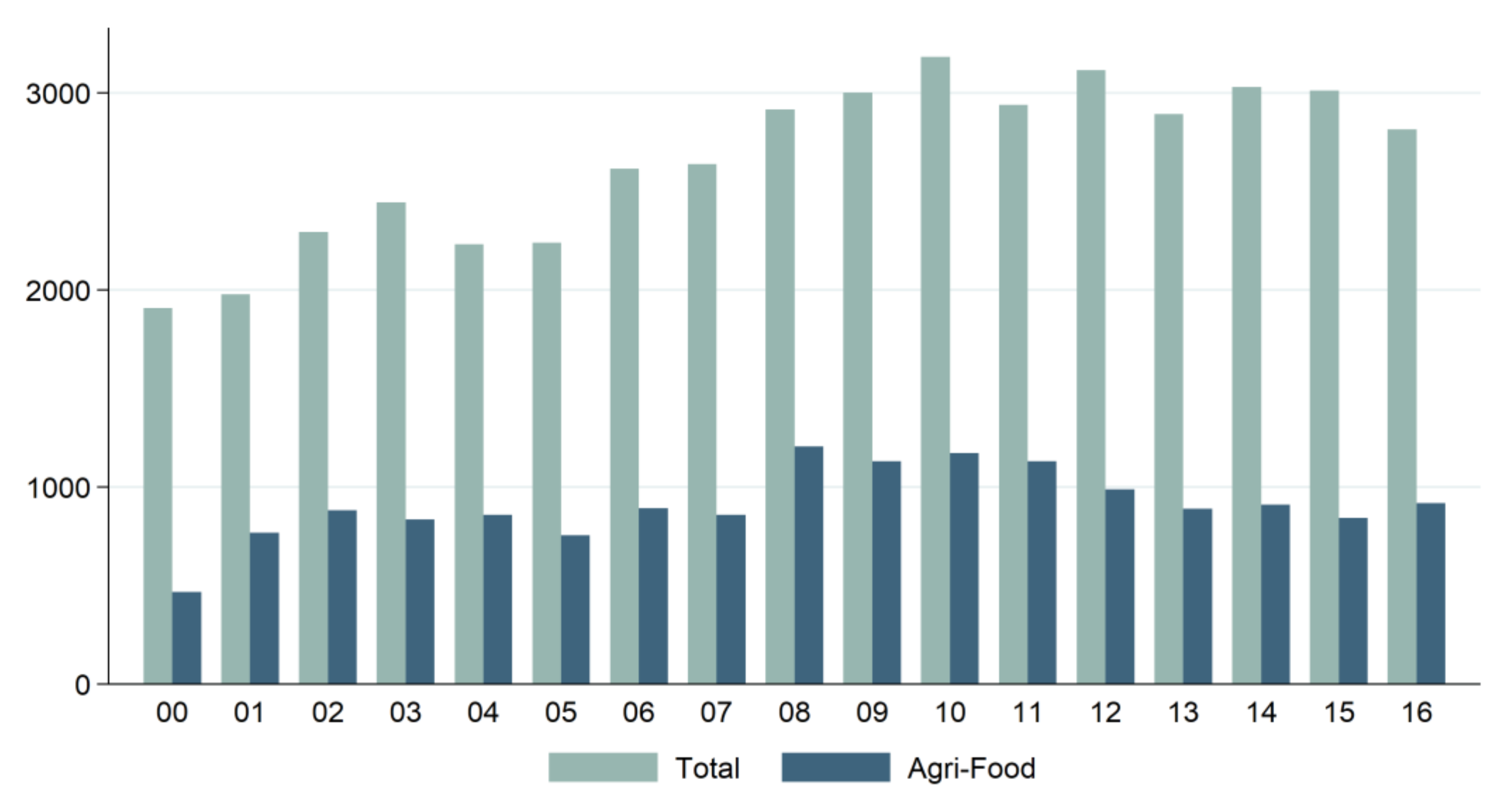
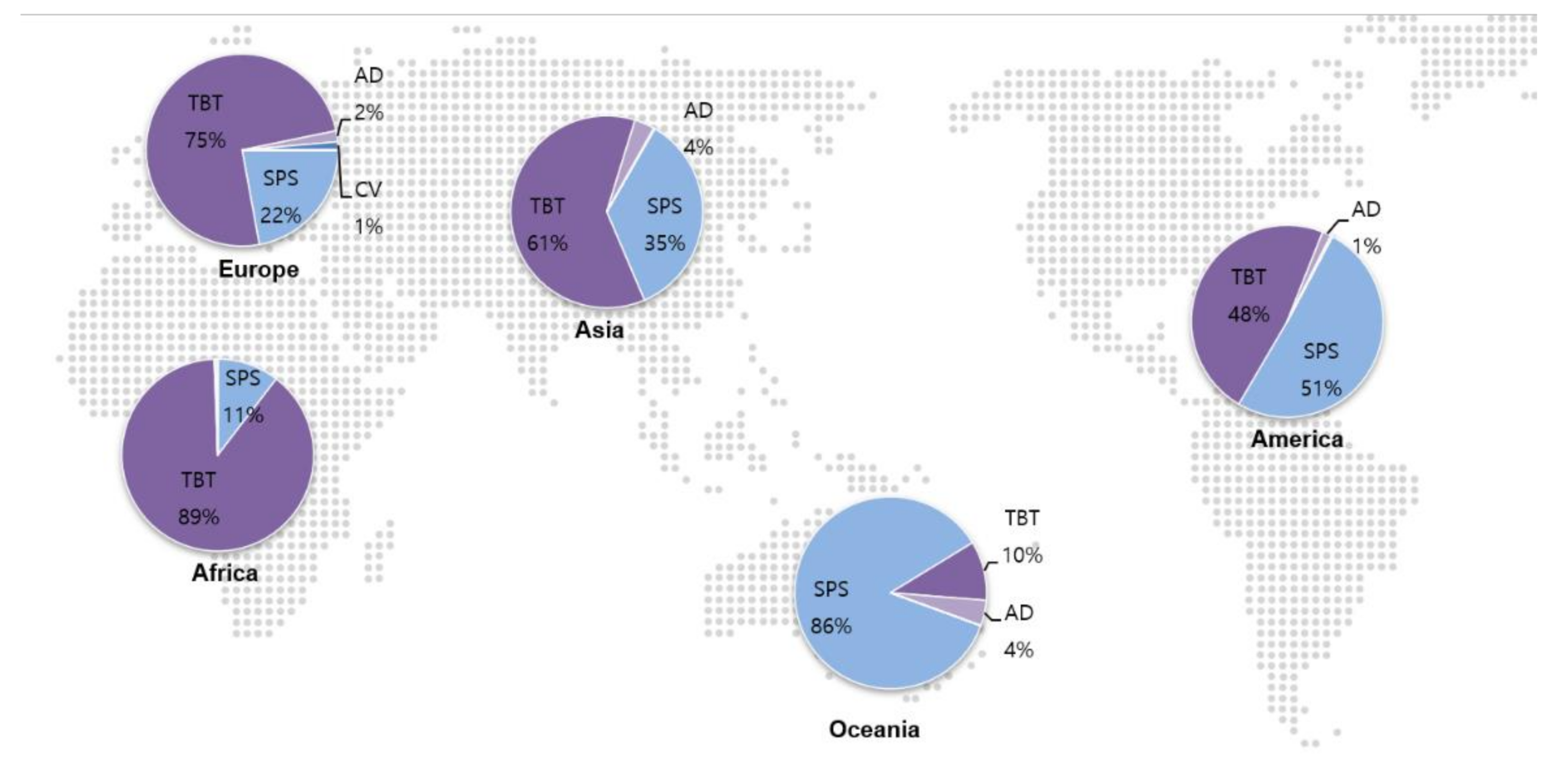

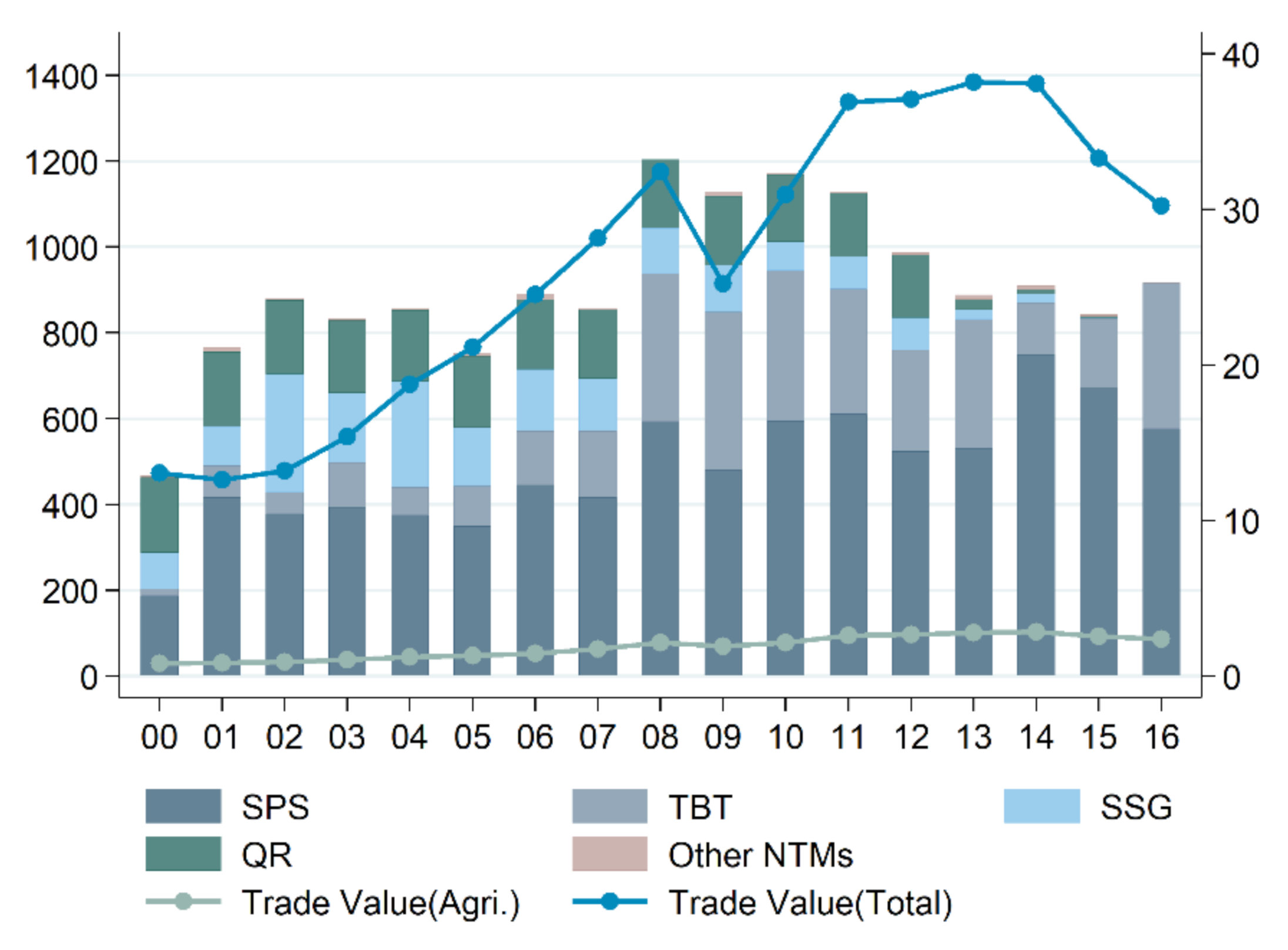
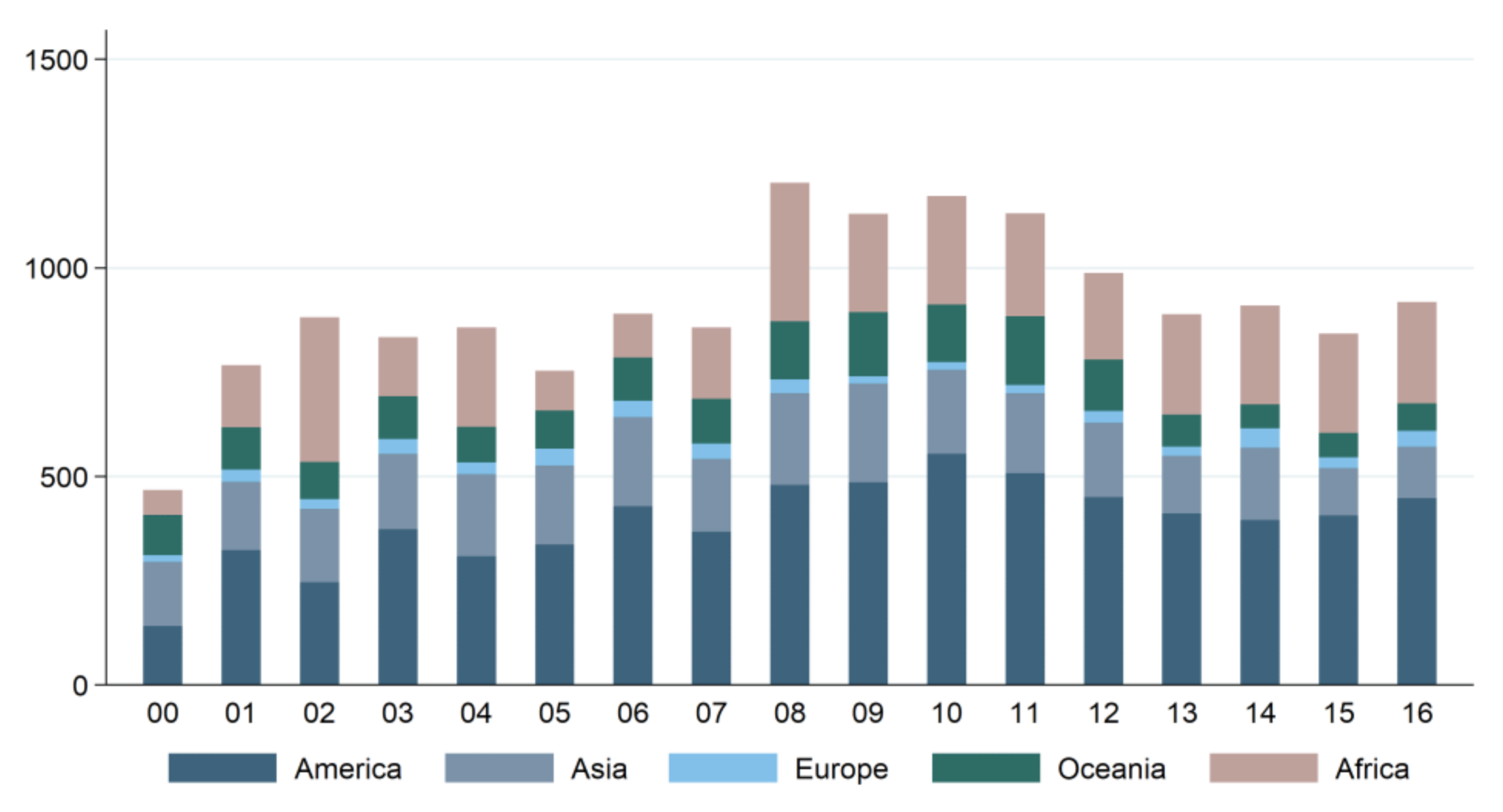
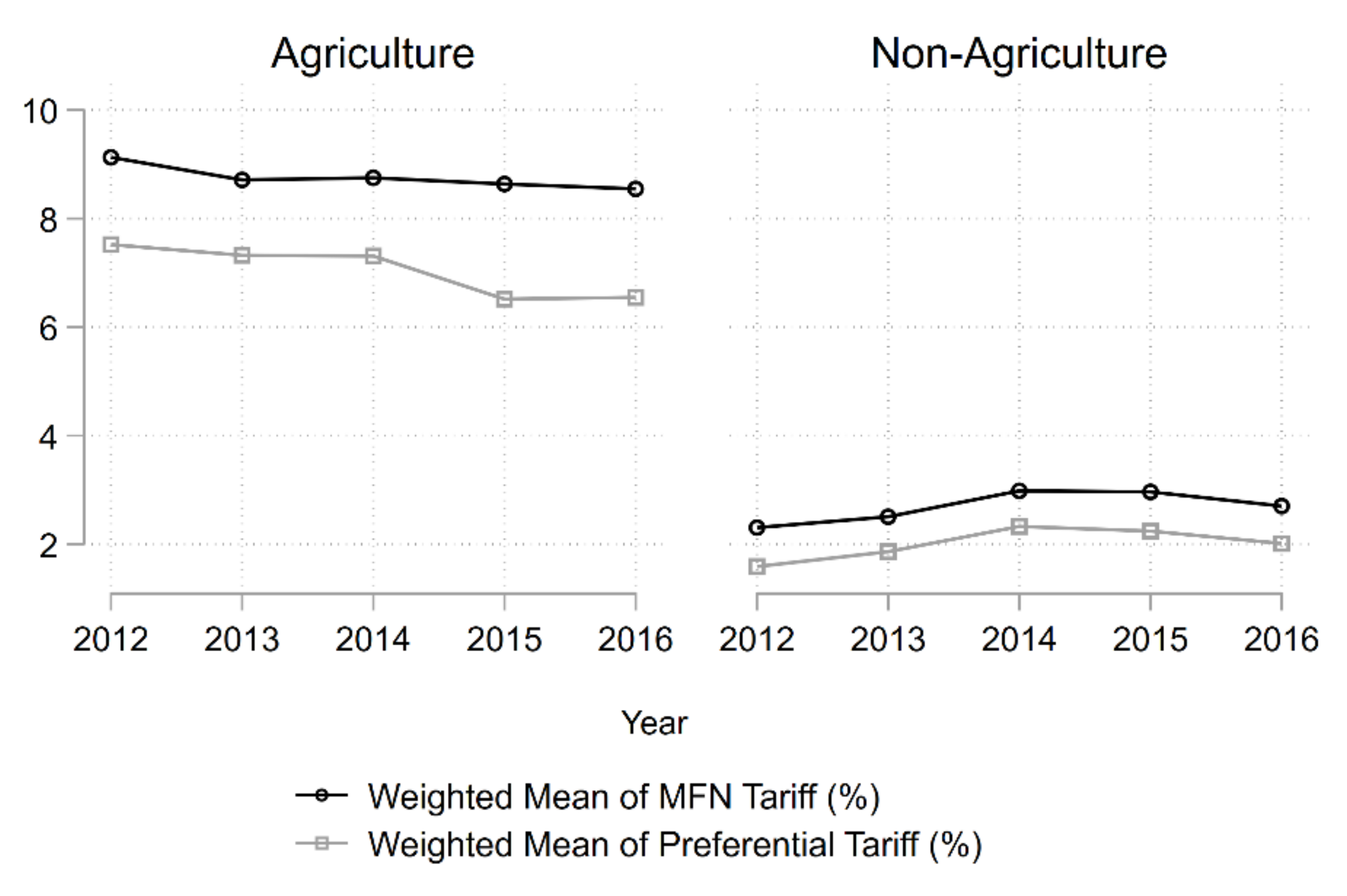
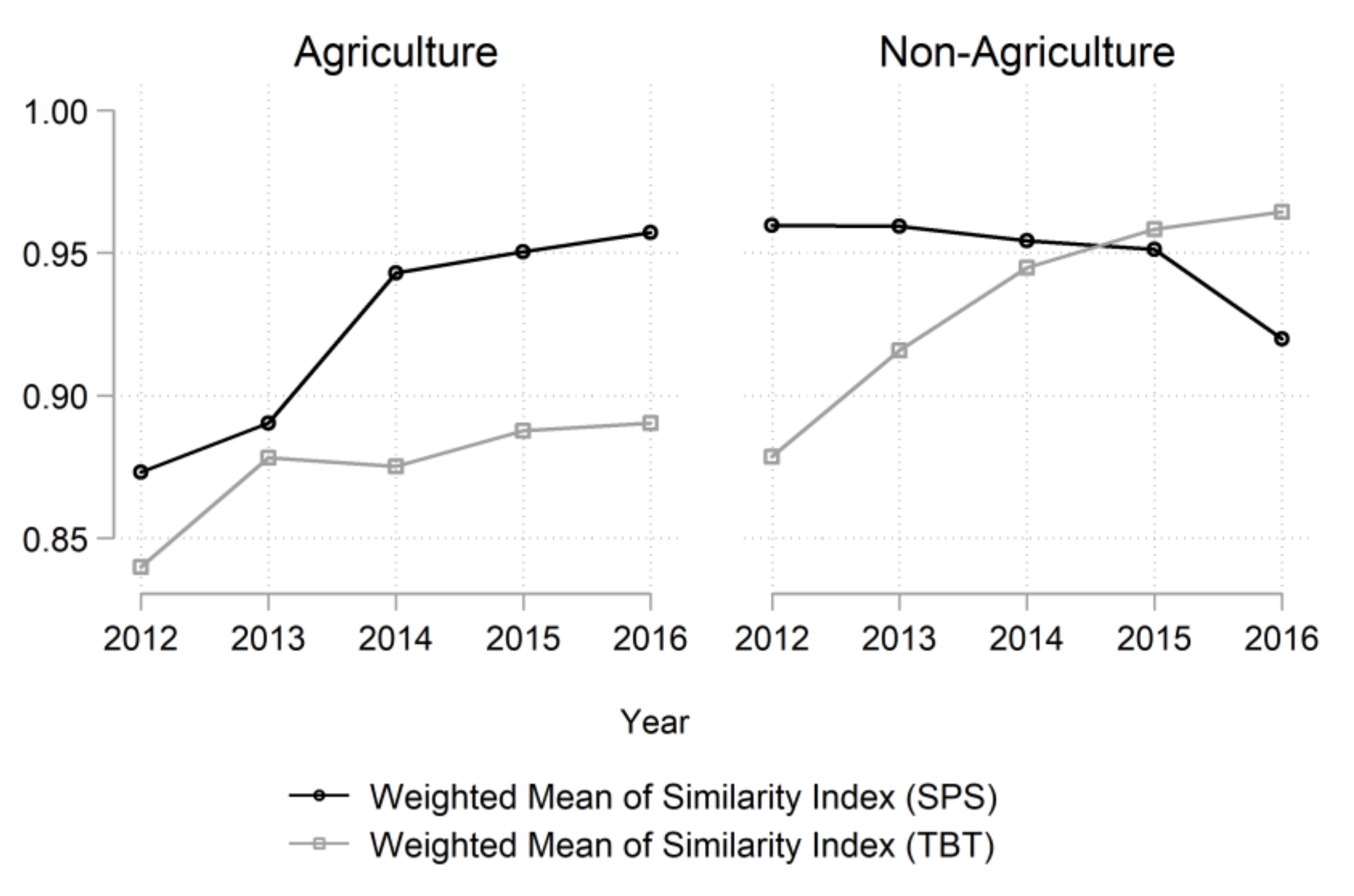
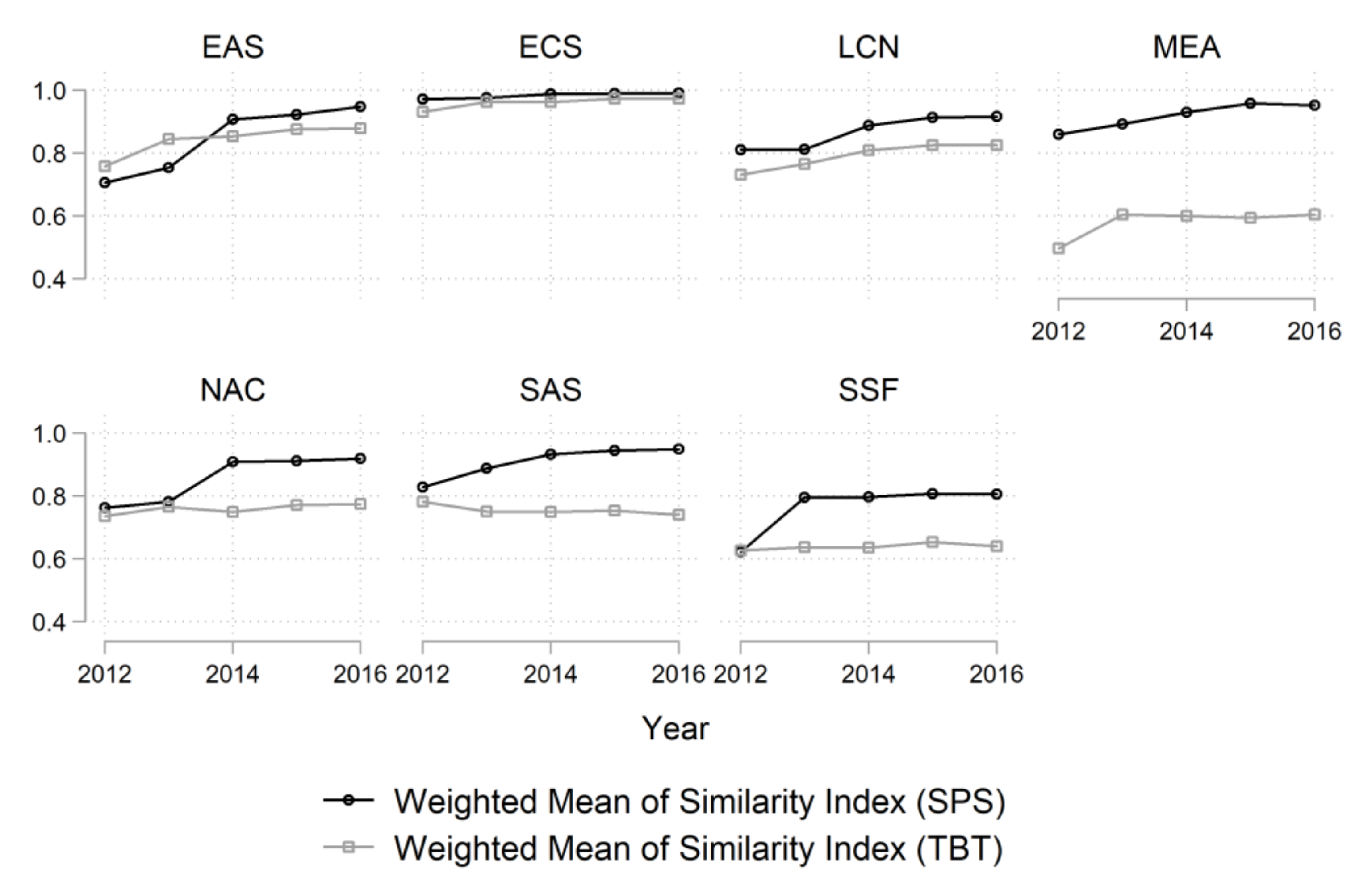
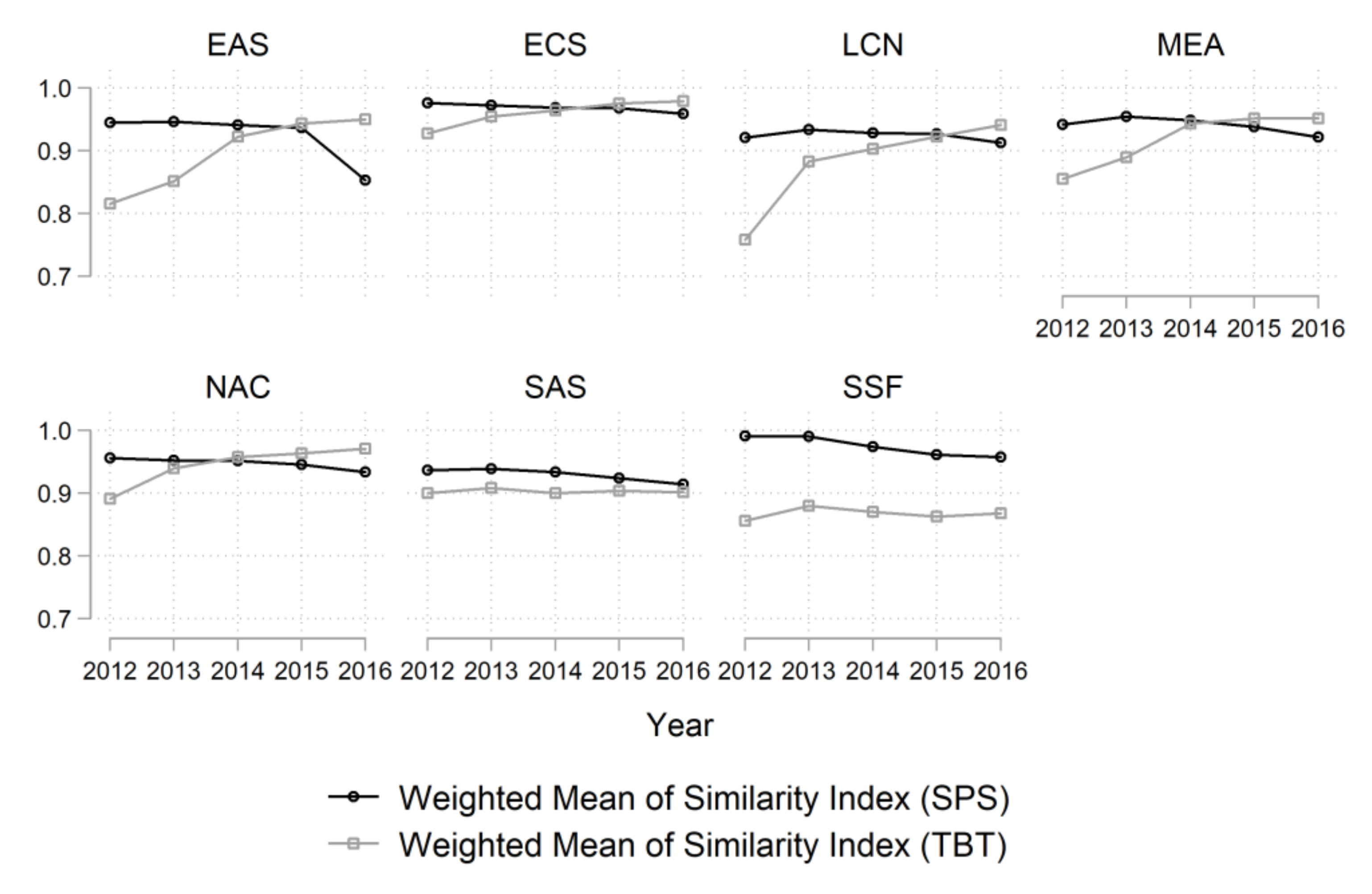
| Variables | Description | Mean | Standard Deviation | Min | Max |
|---|---|---|---|---|---|
| Agriculture (N = 241,960) | |||||
| T | Value of trade (1000 USD) | 18,607 | 130,996 | 1.00 | 16,625,120 |
| lnTpref | ln(1 + Preferential tariff) | 1.34 | 1.34 | 0.00 | 6.07 |
| lnTmfn | ln(1 + MFN tariff) | 1.66 | 1.35 | 0.00 | 6.29 |
| FTA | 1 = RTA | 0.43 | 0.50 | 0.00 | 1.00 |
| SI_sps | Similarity Index (SPS) | 0.90 | 0.23 | 0.00 | 1.00 |
| SI_tbt | Similarity Index (TBT) | 0.77 | 0.36 | 0.00 | 1.00 |
| Nonagriculture (N = 648,322) | |||||
| T | Value of trade (1000 USD) | 72,799 | 883,163 | 1 | 118,465,968 |
| lnTpref | ln(1 + Preferential tariff) | 0.81 | 0.97 | 0.00 | 5.04 |
| lnTmfn | ln(1 + MFN tariff) | 1.09 | 0.97 | 0.00 | 5.33 |
| FTA | 1 = RTA | 0.44 | 0.50 | 0.00 | 1.00 |
| SI_sps | Similarity Index (SPS) | 0.93 | 0.17 | 0.00 | 1.00 |
| SI_tbt | Similarity Index (TBT) | 0.90 | 0.22 | 0.00 | 1.00 |
| Agriculture | Nonagriculture | |||||||
|---|---|---|---|---|---|---|---|---|
| (1) | (2) | (3) | (4) | |||||
| ln(1 + Preferential tariff) | −0.208 | ** | −0.190 | ** | ||||
| (0.037) | (0.026) | |||||||
| ln(1 + MFN tariff) | −0.756 | ** | −0.390 | ** | ||||
| (0.073) | (0.055) | |||||||
| FTA | −0.063 | 0.097 | ||||||
| (0.045) | (0.052) | |||||||
| Similarity Index (SPS) | −0.329 | ** | −0.320 | ** | −0.113 | −0.163 | ||
| (0.121) | (0.121) | (0.093) | (0.094) | |||||
| Similarity Index (TBT) | 0.058 | 0.059 | 0.173 | * | 0.179 | * | ||
| (0.075) | (0.076) | (0.077) | (0.077) | |||||
| Constant | 12.675 | ** | 13.504 | ** | 14.498 | ** | 14.716 | ** |
| (0.135) | (0.157) | (0.114) | (0.129) | |||||
| Exporter–Sector–Year FE | Yes | Yes | Yes | Yes | ||||
| Importer–Sector–Year FE | Yes | Yes | Yes | Yes | ||||
| Pair FE | Yes | Yes | Yes | Yes | ||||
| Pseudo R2 | 0.917 | 0.918 | 0.959 | 0.959 | ||||
| N | 241,878 | 240,834 | 647,976 | 646,537 | ||||
Publisher’s Note: MDPI stays neutral with regard to jurisdictional claims in published maps and institutional affiliations. |
© 2020 by the authors. Licensee MDPI, Basel, Switzerland. This article is an open access article distributed under the terms and conditions of the Creative Commons Attribution (CC BY) license (http://creativecommons.org/licenses/by/4.0/).
Share and Cite
Cho, S.J.; Oh, S.; Lee, S.H. The Impact of Structure Similarity of Nontariff Measures on Agricultural Trade. Sustainability 2020, 12, 10545. https://doi.org/10.3390/su122410545
Cho SJ, Oh S, Lee SH. The Impact of Structure Similarity of Nontariff Measures on Agricultural Trade. Sustainability. 2020; 12(24):10545. https://doi.org/10.3390/su122410545
Chicago/Turabian StyleCho, Sung Ju, Saera Oh, and Sang Hyeon Lee. 2020. "The Impact of Structure Similarity of Nontariff Measures on Agricultural Trade" Sustainability 12, no. 24: 10545. https://doi.org/10.3390/su122410545
APA StyleCho, S. J., Oh, S., & Lee, S. H. (2020). The Impact of Structure Similarity of Nontariff Measures on Agricultural Trade. Sustainability, 12(24), 10545. https://doi.org/10.3390/su122410545





